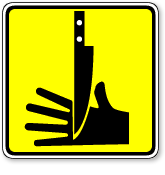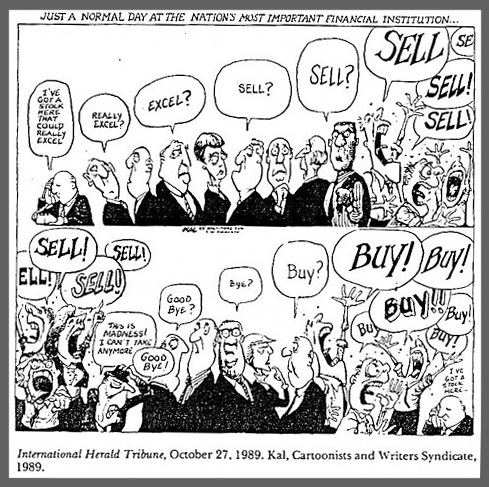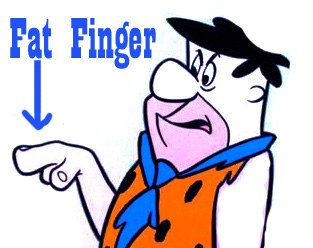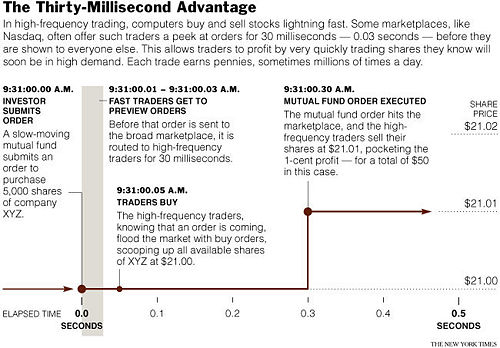05.06.2010
05.08.2010 UPDATE
Anatomy of a Stock Market Sell Off
Investor Education Series written by Net Advisor™
On May 6th, 2010 the Dow Jones Industrial Average (DJIA) or “The Dow” plunged 992.62 points. This is the largest intraday point drop in the history of the U.S. markets. The move was generally blamed by a “fat finger.” Don’t buy this completely.
First, what is fat finger?
Fat Finger is when one makes a typing error. When writing, we call these typos. In stock market terms, fat finger is when you hit the wrong button or make a typo on an order. One may hit the buy button when they meant to hit the sell button; or someone enters “B” (billion), when they meant “M” (million); or one could add too many zeros, such as sell 16,000,000,000 (16 billion) instead of sell 16,000,000 (16 million). These are human errors.
I would agree that “fat finger” could have contributed to the down move, but other factors also occurred.
What do you think happened to cause the sell off?
1. The broad market (referring to the S&P 500 Index) opened lower from the very start of trading on 05-06-2010. The S&P closed on 05-05-2010 at 116.83. On 05-06-2010 the S&P opened at 116.26. Thus we opened down 0.68% – a little over half of one-percent.
2. The S&P reached the high of the day at about 117. This occurred around 7:04AM PST/ 10:04AM EST. By my account the S&P has been showing a long term “sell” since 04-08-2010 Long term SPY Chart (PDF Chart).Thus there are plenty of technical reasons why the market is over due to go lower anyway. I was just waiting for a catalyst to see an actual big downside move. Note the market had been increasing its decline ever since the SEC filed charges against Goldman Sachs (see chart link above).
3. On 05-06-2010, there were live reports on Greece and that was the talk of the day. The EU and Greece problems are nothing new, just that the news is beginning to make bigger headlines, and thus grabbing attention from the market.
4. Peaceful (Greek) protesters were out with 100′s of police in full riot gear on 05-06-2010. As I was watching this with live pictures on TV and seeing the market react, I felt, I don’t know if it’s a good idea to be showing live pictures of all this. I don’t think the market will take this news too well.
5. When the protests turned violent (rocks and fire bombs thrown, etc), the U.S. markets seemed to interpret this as political and economic instability in a country that needs high political and economic stability right now.
Further interpretation, “The violent/ rioting people in Greece don’t get it or take their economic problems seriously.” Thus, the market watching all this unfold, is a confirmation of economic instability, and began selling off. The markets never looked back and trended lower. The U.S. market, the Dow at this point quickly fell from negative 240 to 275 points lower.
6. The S&P had been flirting with technical support levels according to my chart: 2010-05-06 SPY – minuet chart with signals (PDF Chart).
7. Breaking technical support levels can trigger buy or sell programs where baskets of stocks, and stock futures, etc automatically are pre-programmed by computers to react when certain events occur, such as when the market is rising or falling at a predetermined point.
8. The selling was pretty evenly occurring until about 11:38ish AM PST/ 2:38PM EST. The S&P was at around 112.29 at this time and by my chart (above) just was about to break another short term support level. 2010-05-06 SPY – minuet chart (see middle blue line) (PDF Chart). A break below this middle blue line on this said chart, would suggest to me further selling, and that is what we got.
9. The market continued to sell off and the Dow was down 353 points. When the markets make big moves I really start looking at all my data points to see what might be driving this, where are people panicking, and looking for opportunities to buy or short.
I noticed huge put option buying in the S&P 500 Index at the May 114, 115 and 16 strike prices. What I saw next is that the Dow continued to sell off down 420 points, and the S&P 500 followed. This told me that the people buying these put options believe the market will go lower from these strike prices (114, 115, and 116) sometime between now and by Friday May 21st at the latest.
Why lower by Friday 05-21-2010?
That is Options Expiration Day. Thus all options contracts will expire worthless or be exercised for profit based on where the underline stock price is. I know this may be getting a little Greek (no pun intended), but basically know that people are believing the market will drop more from here at any time, and they are placing trades hoping to profit if the market does fall. They can lose money if the market goes higher.
What Happened Next?
10. Enter panic selling. People, (investors, traders) funds, etc. who had made huge gains over the last year saw this as more than an ordinary sell off. So they started to sell and take profits.
12. Margin calls could also been triggered, especially to funds who are highly leveraged in the wrong direction. This can force one or a fund to sell large baskets of stocks, equity futures (such as the e-mini). Essentially you can have a massive amount of stock in large dollar volume being sold all at once.
13. All those who have stop orders also are being triggered. These are people who have orders to automatically sell a stock if it hits at or below a certain predestined number. There is a difference in stop orders, stop limit orders. Most people in my experience use stop orders but I have some thoughts about using them. My 20+ years of experience suggests that whatever price you enter a stop order, you will be stopped out at or below that stop price, no matter how ridiculous high price the stock may be trading. Everyone should have learned this during the .com crash of March 2000-October 2002.
Stop Order Example:
You bought a stock at $60. It’s now $65. You want to sell if it falls down to $61, and you leave want to just leave the order out these so anytime in the future that stop price is hit, the stock’s instructions is to automatically sell. So you enter a stop order also called, a “sell stop” at $61. [Entered like this: “Sell XYZ 61 STOP GTC”.
Sell = you are placing an order to sell
XYZ = the stock symbol or symbol of whatever you are trading.
61 STOP = Command. If the stock falls to in this case $61, a market order is entered to sell at the next available price.
GTC = The order you are placing is “Good Until Canceled.” It will say out there in an electronic system for 30-90 days depending on the rules set by your brokerage firm. If the order is not executed (sold) within the GTC time frame, the order will cancel and you have tom place a new order if you want to sell.
So what did we just do?
If the stock drops to $61, sell it at the next available price. At that time the stock hits $61, the stock becomes a market order to sell. Market Orders are the fastest way to buy or sell in the market, however you are not guaranteed a specific price. To read more about trade execution and placing orders, the SEC has a link for more info.
Next, keep in mind that when you place an order to the market, there are others who are doing the same thing all the time. So in this example, you and 1000′s and 1000′s of others have existing stop orders on a certain stock, and the stops are placed at different prices and even prices down to the penny such as $61.21.
Chart A:
Say we have a sample of stop orders that look like this:
- 1,000 sell stop at $64.50
- 100 sell stop at $64.50
- 10,000 sell stop at $64.45
- 5,000 sell stop at $62.80
- 100,000 sell stop at $61.15
- 50 sell stop at $61.00
What happens when the Market is facing a lot of sell pressure?
Shares to sell are outnumbering shares to buy, and guess where the stock is going? Correct, the stock is going lower. And in a fast moving market, stocks, and in our example gaps down from say $65 to $62 instantly.
Stock Gap Down Example:
On a chart, a gap is when the stock goes from say point A (say it last traded at $65.00) and “drop gaps” to point C (say a drop to $62.00 – immediately). The stock never trades and skips Points B ($64.00) all the way to and Point C ($62.01).
So, remember that you had placed that stop order at $61.00
One problem: Buyers are staying away from the stock, and there are only 1,000 shares to buy at $62. Now what happens?
All stop orders above $62 immediately become open (live) market orders to sell: Thus: “Sell XYZ stock at the next available price.”
The first 1,000 shares from above is executed at $62, even thought the stop was placed at $65.50. This is why I don’t like stop orders. Remember, once the stop price is triggered, the stock is set to sell at the next available price. But notice there are a ton of others who are also got triggered on their stop order.
We have 116,150 shares (from highlighted example above, “Chart A”) that triggered their stops since the next price in the stock is now $62. The only trades that have not been executed (sold) are the 1,000 share sell stop at $58.50 and the 500,000 share (big daddy fund) that has a stop at $50.
Now the stock will fall to the next available price wherever there is a buyer willing to step in and buy.
Example 2:
Say the next price is $58 and there are 20,000 shares ready to buy at that price.
What happens next?
Two more stops get triggered. Referring again to “Chart A,” above, now we have the 50 share stop order @ $61, and 1,000 share stop order at $58.50 get triggered to market orders to sell. Now, these people are all waiting in line of a growing number of market sell orders just waiting for a buyer to take their shares from them. All of this can transpire in seconds to minuets or bit more depending on market conditions.
What happens next?
We said that there was 20,000 shares ready to be bought at $58 (Example 2, above). Thus 20,000 shares get sold at $58 from earlier stop orders waiting to be sold.
Slight problem: We still have 96,150 shares (from “Chart A”) to sell plus the additional stops of $50 and 1,000 shares that got triggered to sell, giving us now 97,200 shares waiting to sell at the next available price.
14. Now here comes Fat Finger Fred, who usually is very accurate when entering orders for his big institution. He, for whatever reason, perhaps eating a cheeseburger on one hand, looking at girls on another monitor, or just makes a human mistake and accidentally hits a wrong key or keys on an incoming order, hence “fat finger.”
Fred hits (for example) “16 B” for 16 Billion instead of “16 M” for 16 million, and send baskets of orders totaling $16 Billion S&P 500 e-mini futures contract to sell at the next available price in the market (market order sell).
Now, in this example, XYZ stock gaps down again and the next available price might go from $58 to say $56. The only problem is that the buyers have not chosen to run in and try to “catch this falling knife.” Then, a few brave souls offer to buy 5,000 shares at $56.

So we still have 92,200 shares still waiting for the next available price: (97,000 shares waiting to be sold from stop orders less 5,000 shares of new buyers).
“Catch a falling knife.” That’s a term on Wall Street for those who try to time the market by buying heavily during a falling market on belief that there’s an imminent rebound. As the term suggests, misjudge your entry point and you could get sliced up pretty badly.” (Source: Bloomberg-Businessweek)
Now, start factoring the 100′s of thousands or millions of shares that are being dumped on the open market at the same time this is occurring from people panicking and or other sell programs getting triggered, and or margin calls in being triggered, all seeking to leave a crowded burning theater with only one exit.
There are no buyers to meet the level of sell demand, so the stock price keeps gapping down looking for buyers to meet the massive sells orders.
Now add Fat Finger Fred with his huge baskets of sell orders hitting the market simultaneously, and it is like a Mac Truck with NASA rocket boosters coming at you at 600 MPH.
15. In our example, we’ll say one of Fat Finger Fred’s baskets of stock to sell included 10 million shares of our XYZ stock, and sell it all at market. Now we have a total of 10 million shares to sell at market plus the existing 92,200 shares of stop orders waiting to be sold at the next available price. Total: 10.0922 million shares need to be sold at the next available price.
Then what happens?
Buyers see this huge sell order dumped on the market, and they stand aside to not get hit by this Mac Truck. No one is there willing to buy. Result: Stock plummets into a free fall.
But then, after a moment of thought, some buyers finally step in and make “ridiculously” low offers to buy XYZ stock. Say collectively, there is an offer to buy a total of 1 million shares at $50, when the last trade was $56.
What happens?
- XYZ stock gaps down from $56 to $50 instantly.
- 1 million shares are bought at $50
- Our last original stop order to sell 500,000 shares at $50 now gets triggered to sell at market… the next available price.
One problem.
We still have 9.0922 million shares need to be sold at the next available price (10.922 outstanding market sell orders – 1 million sold = 9.0922 million left to be sold). Now add another 500,000 shares (the last stop order in “Chart A” that got triggered when the stock busted through $50. Now we have a new total of 9.5922 million shares that need to be sold at the next available price.
Sellers with all these open market orders to sell can cancel their orders IF they can get the order in fast enough. However, remember all of this can transpire in number of seconds to a minute or so depending on the trading situation. Frequently it is difficult to cancel or change orders in fast moving markets because the cancel has to be confirmed before you place a new order. To just cancel it could show pending, and not only would your order be pending, so would the millions of others who are trying to do the same thing.
Next we finally see buyers step up after this plunge to $50 that started when the stock was $65. Fearing the stock could go lower, buyers offer a lower than current bid (price) of $50 to protect themselves from taking on risk that the stock could go even lower, causing them immediate and unknown losses. So buyers as a group offer to pick up all the shares waiting to be sold but their best bid price: $30
What happens now?
With no other buyers at a higher price, the stock gaps down again from $50 to $30 (the new bid price) for a moment where all 10.0922 million shares are bought up. The buyers can be anyone. Mom and pop, mutual funds, pension funds, hedge funds, traders, anyone ready to buy if the price gets low enough, they got an order in timely enough. Stock is now at $30, down 53.8% from $65.
Now what?
- There are no more shares of XYZ stock to sell.
- There are no more stop orders (in this example – “Chart A”).
- More buyers enter the market seeking what appears to be a bargain.
- The stock starts going up now in a sudden surge where new buyers are scrambling to buy in while the price is still low.
- Buy programs are sent to the market to scoop up discounted prices.
Result:
All this new buying pushes XYZ back up to a new market price. There is no set price to where the stock goes up to; it is still determined by buyers and selling buying in or wanting to sell. It is not unusual for the stock to recover 50% of its losses. If the drop was an error such as Fat Finger, or just believed to be an error, then the stock could recover most all its losses, sometimes even out to a gain. Again, the situation various different for every stock, and based on the situational factors of events that unfolded.
Now these are a lot more technical details here, but this is a real basic example of what can happen. This doesn’t happen all the time, but can occur at times of “crisis” or high uncertainty in a stock or the market, or just during in a market panic.
Back to the Broad Market Sell Off
16. We saw the market come from being down almost a 1,000 point drop to down only 495 points. As the market moves off the lows, buy signals are triggered and more and more buyers come in and buying. The stock bounces around from people who made a quick buck buying low, to people who wanted to get out but never sold. Then you have people who want to sell into strength on the rebounding stock or looking to sell the rebounding overall market. All of this is called “volatility.” If one doesn’t have the stomach for this, one should not be a trader.
17. The index that measures volatility, “CBOE Vix” (also called the “Fear Gauge”). The Vix rises as the market becomes more volatile. The Vix was up a record 51% on this day, the biggest 1 day increase ever.
18. There also could have been other issues that caused the down turn, and part of me says this was part of the problem. Flash Trading on thinly traded OTC (Over the Counter) markets. I am actually against the use of flash trading as it is gives an unfair advantage against the average investor who is not using this technology.
There was talk from the NYSE floor on Thursdays (05-06-2010) post market close that the NYSE floor traders tried to slow down the market from free fall, or at least slow trades coming to the NYSE by 30 seconds. When certain members of the NYSE slowed down or halted traded, program orders were rerouted (automatic or manual is the question) to other exchanges that refused to slow or halt trading. These other markets have very thin volume, thus a big order can easily move a stock.
To give an example, through computers, a flash trade occurs within ½ second or less, and one could send 10,000 orders to buy or sell and be done before you could blink your eye.
So we could have seen orders slow up at the NYSE trying to get people to “calm down” just for 30 seconds, but programs routed to other markets and send flash programs sells that helped drop stock (bid) prices. Note all the other factors such as have a trail of stop orders can magnify the drop, so can margin calls.
Flash trading is not new. It has been in controversy for at least since 2009.
According to the SEC and CFTC, the FEDs have traced the “Flash Crash” back to Chicago.
19. Summary:
- So what we had is a market that had a huge run from March 2009 to April 2010.
- We had the NY terror issue in Times Square, plus FinREG, plus the Goldman Sachs-SEC case. We also have (not well reported) China tightening credit (story ID #532111 link gone) (again). We have the Flash Crash, and even with that, the technical trends turning negative, suggesting we could go lower still. We have high political instability in the EU – not just Greece but further fallout from what could happen next – Portugal, Spain, etc. And Friday May 21st, 2010 is options expiration day.
20. Again, the technical trends are still longer term negative. Sure we can rebound on a technical bounce and this is normal, but I think we could end up going lower over the next several weeks or so.
On a lighter note, I also did some real time tweets on this day so those interested and not watching the action could follow.
Happy Trading.
Education Note:
To learn more about how options work, this is where I first learned (before the Internet): The Options Industry Council (OIC): website: 888-options.com.The OIC is the official education arm of the Options Clearing Corporation. All the info and classes are free as far as I know. They were all free when I took them. There is no need to spend $5,000+ to go to a seminar to learn how to trade or invest. A good professional advisor can also help you with that for free. They are based by commission or fees. If you choose an advisor, I would prefer one who is BOTH Series 7 and Series 4 licensed with 10+ years trading experience with options.
Options Risk Disclosure:
“Prior to buying or selling an option, investors must read a copy of the Characteristics & Risks of Standardized Options, also known as the options disclosure document (ODD). It explains the characteristics and risks of exchange traded options.” (Source: Options Clearing Corporation) Legal Disclaimer.
images/ graphics (c) respective owner(s)
Copyright © 2010 Net Advisor™
NetAdvisor.org® is a non-profit organization providing public education and analysis primarily on the U.S. financial markets, personal finance and analysis with a transparent look into U.S. public policy. We also perform and report on financial investigations to help protect the public interest. Read More.




